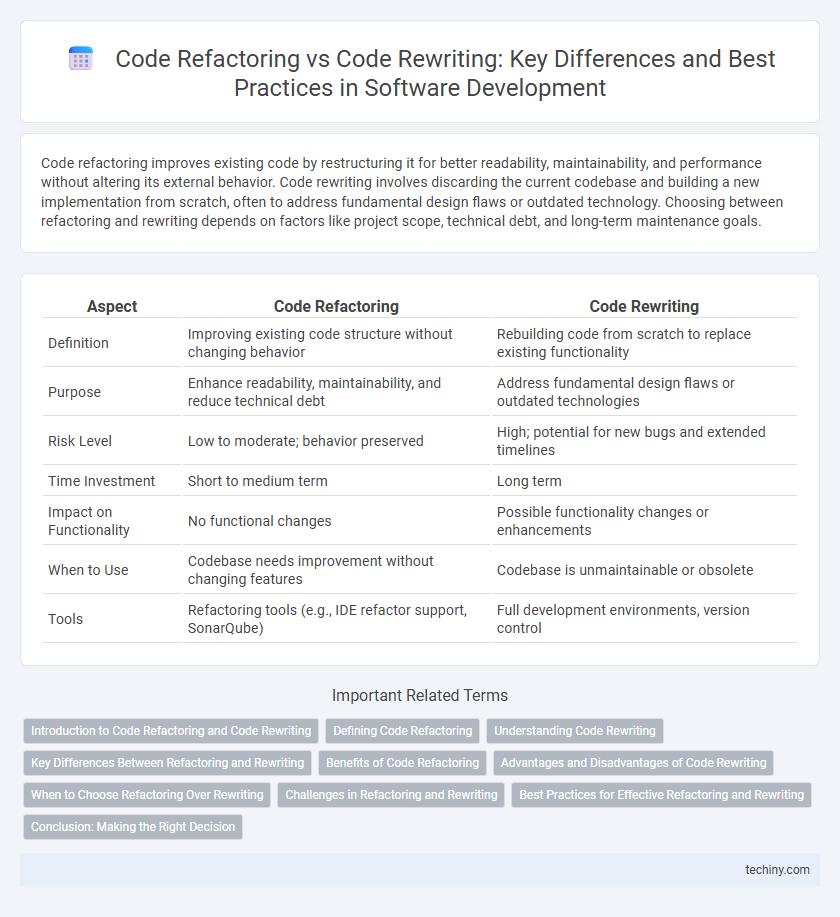Code refactoring improves existing code by restructuring it for better readability, maintainability, and performance without altering its external behavior. Code rewriting involves discarding the current codebase and building a new implementation from scratch, often to address fundamental design flaws or outdated technology. Choosing between refactoring and rewriting depends on factors like project scope, technical debt, and long-term maintenance goals.
Table of Comparison
| Aspect | Code Refactoring | Code Rewriting |
|---|---|---|
| Definition | Improving existing code structure without changing behavior | Rebuilding code from scratch to replace existing functionality |
| Purpose | Enhance readability, maintainability, and reduce technical debt | Address fundamental design flaws or outdated technologies |
| Risk Level | Low to moderate; behavior preserved | High; potential for new bugs and extended timelines |
| Time Investment | Short to medium term | Long term |
| Impact on Functionality | No functional changes | Possible functionality changes or enhancements |
| When to Use | Codebase needs improvement without changing features | Codebase is unmaintainable or obsolete |
| Tools | Refactoring tools (e.g., IDE refactor support, SonarQube) | Full development environments, version control |
Introduction to Code Refactoring and Code Rewriting
Code refactoring involves restructuring existing code to improve its readability, maintainability, and performance without changing its external behavior, often using techniques like code simplification, modularization, and optimization. Code rewriting entails discarding existing codebases to develop new software versions from scratch, typically pursued when legacy code is too complex or outdated for efficient modification. Understanding the distinctions between refactoring and rewriting is crucial for software development teams aiming to balance technical debt, project timelines, and system stability.
Defining Code Refactoring
Code refactoring involves restructuring existing code without altering its external behavior to improve readability, maintainability, and performance. It focuses on cleaning up the internal structure by removing code smells, duplications, and inefficiencies while preserving functionality. This practice enhances software quality and reduces technical debt, enabling smoother future development and debugging processes.
Understanding Code Rewriting
Code rewriting involves completely discarding existing code to build a new system from scratch, often chosen when legacy code is outdated, incompatible, or poorly maintainable. This approach allows developers to implement modern architectures, adopt updated technologies, and improve overall system performance without legacy constraints. While time-consuming and resource-intensive, code rewriting can eliminate accumulated technical debt and enhance scalability and security compared to incremental code refactoring.
Key Differences Between Refactoring and Rewriting
Code refactoring involves restructuring existing code to improve readability, maintainability, and performance without changing its external behavior, while code rewriting entails discarding the old code base and developing a new system from scratch, often to address fundamental architectural flaws or outdated technology stacks. Refactoring is typically less risky and more incremental, enabling continuous improvement in agile development environments, whereas rewriting carries higher risks and longer timelines due to scope, resource allocation, and potential for reintroducing bugs. Choosing between refactoring and rewriting depends on code complexity, technical debt levels, and project goals such as scalability, feature enhancement, or technology modernization.
Benefits of Code Refactoring
Code refactoring enhances software maintainability by improving code structure without altering its external behavior, leading to easier debugging and future feature integration. It reduces technical debt by systematically eliminating code smells and optimizing performance, which helps prevent software rot over time. Continuous refactoring also promotes better collaboration among development teams by ensuring a clean, consistent codebase aligned with best practices.
Advantages and Disadvantages of Code Rewriting
Code rewriting offers the advantage of a cleaner, more maintainable codebase by eliminating legacy issues and integrating modern technologies, which can enhance performance and scalability. However, it involves significant time and resource investments, increasing project risks related to potential bugs and loss of original functionality during the redevelopment phase. Choosing code rewriting over refactoring demands careful consideration of long-term benefits against short-term disruptions and costs.
When to Choose Refactoring Over Rewriting
Code refactoring should be chosen over rewriting when the existing codebase is fundamentally sound but requires improvements in structure, readability, or maintainability to reduce technical debt. Refactoring minimizes risks by preserving the original functionality while enabling incremental enhancements, which is ideal for projects with tight deadlines or limited resources. It is most effective when the goal is to optimize performance and code quality without discarding valuable business logic embedded in the current system.
Challenges in Refactoring and Rewriting
Code refactoring challenges include maintaining functionality while improving code structure, managing dependencies, and ensuring comprehensive testing to prevent regression issues. Code rewriting demands significant time investment, complete understanding of existing requirements, and risk of introducing new bugs due to absence of the original logic. Both processes require thorough documentation and clear version control to mitigate risks associated with complex software systems.
Best Practices for Effective Refactoring and Rewriting
Effective code refactoring involves incremental improvements to existing code to enhance readability, maintainability, and performance without altering its external behavior. Code rewriting is best reserved for scenarios where the existing codebase is overly complex, outdated, or incompatible with new technologies, requiring a fresh architecture. Adopting automated testing, continuous integration, and clear documentation ensures both refactoring and rewriting processes maximize code quality and minimize risks.
Conclusion: Making the Right Decision
Choosing between code refactoring and code rewriting depends primarily on the existing codebase quality and project deadlines. Refactoring improves maintainability and performance with minimal risk by incrementally enhancing the current code, while rewriting offers a clean slate to implement modern architecture but involves higher time and resource investment. Evaluating factors such as technical debt, team expertise, and long-term scalability ensures an informed decision aligning with business goals and development efficiency.
Code Refactoring vs Code Rewriting Infographic

 techiny.com
techiny.com